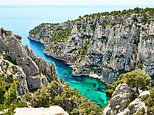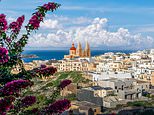
Volcanos, exotic wildlife, jaw-dropping rock formations and otherworldly mountains.
These are all features found in our pick of 12 of the world’s most incredible national parks.
We had quite a few to choose from – there are 113,000 in total – but our selection highlights the sheer variety of landscapes on offer.
Scroll down and you’ll tour breathtaking coastlines from Australia to England, volcanic landscapes in Hawaii, waterfalls in Croatia that’ll leave you wide-eyed with wonder and peaks in China that inspired James Cameron’s Avatar.
With national parks covering six per cent of the planet’s land surface, there’s a lot to explore. The dozen below will get you off to a great start…
1. Khao Sok National Park, Thailand
Khao Sok National Park boasts rainforest, waterfalls, majestic limestone cliffs and an island-studded lake. And it’s home to tigers and elephants
Khao Sok National Park, in southern Thailand, was established in 1980 – though the rainforest within is believed to be older than the Amazon – and the dramatic mountains that ‘loom’ over the island-studded lake at its heart were formed during the same tectonic shift that created the Himalayas.
The park’s official website claims that Khao Sok also boasts waterfalls and majestic limestone cliffs within its 739 square kilometres, with 48 species of mammal including endangered tigers and 200 wild Asian elephants calling it home.
2. Kruger National Park, South Africa
Kruger National Park is home to antelopes, wild dogs, rhinos, zebras, elephants, buffalo, lions, leopards and Cape African giraffes
Kruger National Park is enormous, covering two million hectares, and it’s home to ‘an impressive number of species’, according to South African National Parks – 336 types of tree, 49 fish, 34 amphibians, 114 reptiles, 507 birds and 147 mammals.
The animals you might catch sight of while on a safari or tour include antelopes, wild dogs, rhinos, zebras, elephants, buffalo, lions, leopards and Cape African giraffes.
Not only does the ‘magnificent’ reserve have a public-entry game park, that’s an area set aside for wild animals, but it offers historical and archaeological sites, such as the bushman rock paintings – ancient artwork made by indigenous South Africans depicting non-human beings, hunters and hybrid creatures.
3. Peak District National Park, England
Peak District National Park contains wild mountainous terrain, prehistoric forts and Roman settlements
England’s Peak District covers parts of Derbyshire, Yorkshire, Staffordshire, and Cheshire and was the first area to be designated as a national park in the UK, back in 1951.
According to the official website, the 1,438-square-kilometre park has ‘three main landscapes’ – the Dark Peak, a wild northern mountain territory covered in heather; the White Peak, a softer southern limestone plateau; and South West Peak, an area of foothills and upland.
The park also has ‘an abundance of plants and animals’, along with prehistoric forts, Roman settlements, medieval castles and stone walls for visitors to discover.
4. Port Campbell National Park, Australia
Port Campbell National Park in Victoria, Australia, boasts breathtaking rock formations carved out by erosion, including London Bridge, The Grotto and Loch Ard Gorge (pictured)
Port Campbell National Park is a region in Victoria where the ‘wild Southern Ocean has carved the coastline’ into unusual rock formations including London Bridge, The Grotto and Loch Ard Gorge, explains Parks Victoria.
Another highlight of the 1,750-hectare park is the ‘unmissable’ Twelve Apostles – limestone stacks that light up at sunset in myriad colours.
You can see the views by taking ‘one of the world’s most celebrated scenic drives’ along the Great Ocean Road or get stuck into nature-based experiences including mountain biking, boating, four-wheel driving, indigenous culture tours, birdwatching, surfing and diving.
And while the park’s coastline is treacherous for boats – it’s known as ‘Shipwreck Coast’, with over 630 known shipwrecks – it’s paradise for wildlife. Animals that thrive there include ‘little penguins’, kangaroos, platypus, possums and bandicoots.
5. Zhangjiajie National Forest Park, China
The Unesco-listed Zhangjiajie National Forest Park is home to a rice terrace 1,000 metres (3,280ft) above sea level
The Unesco-listed Zhangjiajie National Forest Park of South Central China’s Hunan Province has dramatic soaring peaks covered in trees.
Truly otherworldly, with the park serving as inspiration for the ‘floating mountains’ in blockbuster movie Avatar.
The park is also home to small villages and the ‘air garden’ – a startling rice terrace 1,000 metres (3,280ft) above sea level.
6. Yorkshire Dales National Park, England
The Yorkshire Dales National Park, in England, is filled with natural wonders from valleys – known as dales – to crags and cliffs, a labyrinth of underground caves, drystone walls (pictured) and heather moorland. Above, the park’s Winskill Stones Nature Reserve near the village of Settle
The Yorkshire Dales, covering 2,179 square kilometres in northern England, is filled with natural wonders from valleys – known as dales – to crags and cliffs, a labyrinth of underground caves and heather moorland.
The official website states: ‘Stone-built villages sit amongst traditional farming landscapes of field barns, drystone walls and flower-rich hay meadows, and show how the area has been shaped over thousands of years by the people who have lived and worked here.
‘Spectacular waterfalls and ancient broadleaved woodland contrast with the scattered remains of former mine workings and other rural industries, which remind us of the area’s rich industrial heritage. Together, nature and people have created a special landscape of immense beauty and character.’
7. Bryce Canyon National Park, Utah, U.S
Bryce Canyon National Park is most famous for its spectacular bright-crimson hoodoos – tall, thin spires of rock formed by rainwater and ice. Pictured: Thor’s Hammer hoodoo
This desert reserve in Utah is only 145.5 square kilometres (56 square miles), but it packs plenty of punch.
It’s most famous for its spectacular bright-crimson hoodoos – tall, thin spires of rock formed by rainwater and ice. In fact, according to the National Park Service (NPS), it has ‘the largest concentration found anywhere on Earth’.
There is plenty of flora and fauna, too. Bryce Canyon is home to more than 100 species of birds, dozens of mammals – including deer, prairie dogs, chipmunks and mountain lions – and more than a thousand plant species, the NPS reveals.
What’s more, the park offers star-gazers extremely dark skies, perfect for astrophotography and gazing at the heavens through a telescope.
8. Loch Lomond and The Trossachs, Scotland
Loch Lomond and The Trossachs National Park encompasses 1,865 square kilometres (720 square miles) and within that expanse there are 21 munros (mountains above 3,000ft), 22 larger lochs and 50 rivers. Above – Loch Lomond
Centred around Loch Lomond, just 45 minutes north of Glasgow, and the hills and glens of the Trossachs, this Scottish national park offers visitors ‘some of the most stunning scenery in the world’, claims the Park Authority – ‘from breathtaking mountains and glens to the vast tranquil beauty of our lochs’.
The park encompasses 1,865 square kilometres (720 square miles) and within that expanse there are 21 munros (mountains above 3,000ft), 22 larger lochs and 50 rivers.
Tourists can visit Inchcailloch – an island on Loch Lomond – that is ‘carpeted in bluebells’ in spring, ‘becomes a rich habitat’ in summer and attracts wildfowl in autumn, while camping, angling, climbing and loch cruises are all popular at this national park.
9. Plitvice Lakes National Park, Croatia
Plitvice Lakes, above, in Croatia, is known for its chain of 16 terraced lakes and stunning waterfalls
Plitvice Lakes is a 295-square-kilometre park known for its chain of 16 terraced lakes and stunning waterfalls that tumble into a limestone canyon. It is the oldest and the largest national park in the Republic of Croatia.
Plitvice Lakes National Park was inscribed on the Unesco World Heritage List because of these unusual lakes. They’re formed by ‘tufa barriers’, where calcium carbonate from the water solidifies onto various surfaces creating shelf-like cascades that can be seen in the image above.
The park is home to 259 species of animal and 1,400 plants, which totals up to 30 per cent of Croatia’s flora and fauna, reports Plitvicka Jezera. The park also has its own hotel built onto a plateau and walkways for tourists among the lakes.
10. Hawaii’s Volcano National Park, U.S
Hawaii’s Volcano National Park (above) is a designated International Biosphere Reserve and Unesco World Heritage Site. Visitors can hike volcanic terrain, take a scenic crater-rim tour around the summit of volcano Kilauea and drive down the slopes of Kilauea to the sea
Hawaii’s Volcano National Park is as explosive as national parks come, encompassing the summits of two active volcanoes – Mauna Loa, the world’s largest shield volcano, and Kīlauea, the most active volcano on Hawaii.
Kilauea erupted ‘almost continuously’ from 1983 to 2018, according to the United States Geological Survey.
This designated International Biosphere Reserve and Unesco World Heritage Site, extending from sea level to 13,680 feet, ‘protects some of the most unique geological, biological, and cherished cultural landscapes in the world’, the National Park Service states.
Things to do? Visitors can hike volcanic terrain, take a scenic crater-rim tour around the summit of Kilauea and drive down the slopes of Kilauea to the sea, an experience the NPS describes as ‘spectacular’.
11. Calanques National Park, France
Calanques National Park in Provence has been dubbed a ‘natural and cultural jewel in the Mediterranean’. Above, remote bay Calanque d’En-Vau, near Cassis
Parc National des Calanques declares that this French reserve in Provence is a ‘natural and cultural jewel in the Mediterranean’, covering 8,500 hectares on land and even more by sea.
Calanques are limestone formations that stretch for 12 miles from Marseille to the small town of Cassis to the east – and are breathtaking to behold, as the above image shows.
The calanques site became France’s 10th national park in 2012 and shields 140 protected land animal and plant species, and 60 marine heritage species.
Visitors can explore it by kayak and boat – and there are a few beaches there they can throw their towel down on (though they’re typically quite difficult to reach).
12. Exmoor National Park, England
Exmoor National Park, in South West England, boasts some of the UK’s darkest skies and dramatic coastline. Above, a view of the Valley Of The Rocks from Hollerday Hill
This national park in South West England may surprise visitors due to its unusual residents – wild ponies that roam freely on the moors (don’t try to ride them).
The park is made up of moorland, farms, woodland, rivers and streams as well as a ‘dramatic’ coast where high cliffs loom over the Bristol Channel.
Exmoor boasts some of the UK’s darkest skies, so visitors can ‘see literally thousands of stars and astronomical sights such as the Milky Way with the naked eye’ on a cloudless night, the National Park’s official website states.
It adds: ‘On Exmoor, it is still possible to find tranquillity and peace as well as rediscover your sense of adventure; to catch a glimpse of wild red deer, be amazed by dark skies full of stars and explore villages full of character and charm.’
Source link
CHECK OUT: Top Travel Destinations
READ MORE: Travel News



